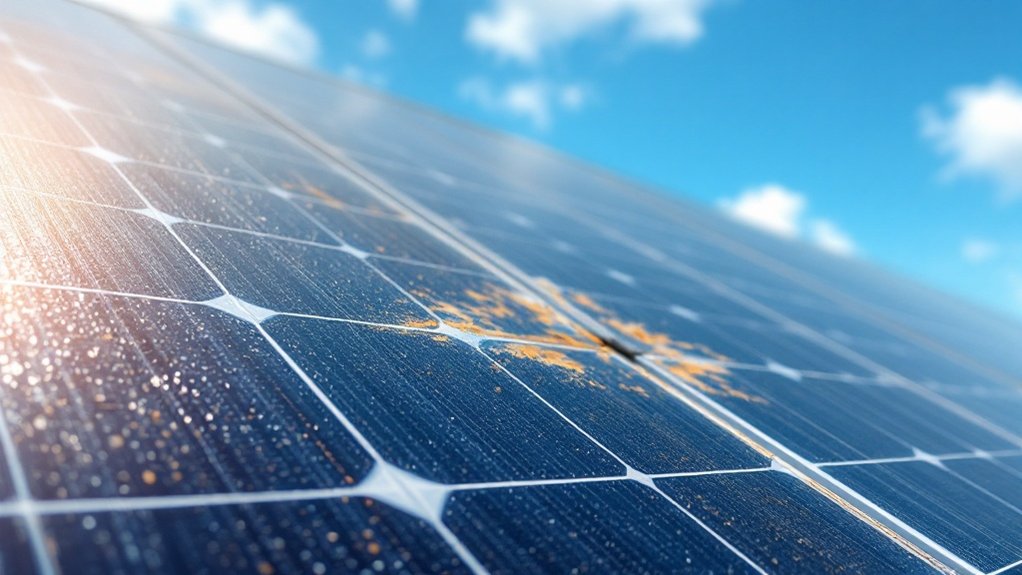Solar panels typically last 25 to 30 years, maintaining 80-90% of their original power output by the end of this period. They lose about 0.5% to 0.8% efficiency each year due to natural degradation from sun exposure, weather, and temperature changes. High-quality panels can function beyond 40 years, though at reduced capacity. Most manufacturers offer 25-year warranties guaranteeing minimum performance levels. Understanding the factors affecting panel longevity reveals opportunities for maximizing their lifespan.

While solar panels represent a significant investment in renewable energy, they typically last between 25 to 30 years before needing replacement. During this time, the panels continue to produce electricity, though their efficiency gradually decreases. Studies show that panels lose about 0.5% to 0.8% of their production capacity each year, resulting in 80% to 90% of their original output after 25 to 30 years of use.
Several factors influence how long solar panels last. The quality of materials used in manufacturing, installation methods, and local environmental conditions all play essential roles. Weather events, accidents, and maintenance practices also affect panel longevity. High-quality materials like solar glass significantly enhance durability and resistance to degradation. Some high-quality panels can continue functioning for more than 40 years, though at reduced efficiency levels. Regular professional maintenance packages can help maximize panel lifespan and performance.
Solar panel longevity depends heavily on material quality, proper installation, and environmental factors, with premium panels potentially lasting beyond 40 years.
Solar panels experience different types of degradation over time. In the first year, panels undergo light-induced degradation. Other forms include potential-induced degradation, UV damage, stress from temperature changes, and corrosion from moisture exposure. Regular monitoring helps identify these issues early. Their sustainable design using recyclable materials helps minimize environmental impact during production and disposal.
Most manufacturers provide warranties lasting 25 to 30 years. These typically guarantee that panels will maintain 80% to 90% of their original power output after 25 years. Product warranties covering defects usually last 10 to 12 years. Premium panel manufacturers sometimes offer extended warranties up to 40 years.
When panels reach the end of their useful life, various disposal options exist. Many components, including glass, aluminum, and semiconductor materials, can be recycled. Some panels can be refurbished and resold. The solar industry continues developing more efficient recycling methods and implementing producer responsibility programs.
Research in solar technology focuses on creating more durable panels and extending their lifespan. New developments include self-cleaning coatings to reduce degradation and improved materials that resist weather damage. Scientists believe future panels could potentially last more than 50 years as technology advances.
These improvements, combined with better recycling methods, make solar panels an increasingly sustainable energy solution.
Frequently Asked Questions
Can Solar Panels Withstand Extreme Weather Conditions Like Hail and Hurricanes?
Modern solar panels are engineered to handle severe weather conditions.
They're certified to withstand winds up to 150 mph and can survive direct hits from 1-inch hailstones traveling at 50 mph.
Studies show these panels have successfully endured Category 4 hurricanes and maintain a remarkably low 0.1% annual failure rate from hail damage.
Their waterproof design and tempered glass construction provide protection against storms.
How Often Should I Clean My Solar Panels for Optimal Performance?
Regular solar panel cleaning is needed 2-3 times per year to maintain peak performance.
Dirty panels can lose 5-30% efficiency due to dust and grime buildup. Locations near highways, factories, or trees may require more frequent cleaning, up to 3-4 times annually.
While rain helps remove some dirt, it's not enough for thorough cleaning.
Energy output typically improves by 5-12% after proper cleaning.
What Happens to Solar Panels After They Reach Their End-Of-Life?
Solar panels that reach the end of their life can be recycled to recover valuable materials.
The recycling process involves taking apart the aluminum frame, separating glass from silicon, and crushing components. Up to 95% of panel materials are recyclable, with glass making up 75% of the weight.
Special facilities extract precious metals like silver and copper. By 2050, recycled panels could yield 78 million tonnes of raw materials.
Do Solar Panels Work During Power Outages or Blackouts?
Most solar panels don't work during power outages due to safety requirements. They automatically shut down to prevent sending electricity back to the grid, which could harm repair workers.
However, homes with battery backup systems can still use solar power during blackouts. Some specialized inverters also allow limited daytime solar power use when the grid is down.
Can I Upgrade Individual Solar Panels Without Replacing the Entire System?
Individual solar panels can be upgraded within an existing system, but specific conditions must be met.
The new panels need to match the voltage and compatibility requirements of the current setup. The system's inverter capacity limits the total power output.
While it's technically possible, mixing different panel types can reduce overall system efficiency.
Professional assessment is needed before any upgrades.








